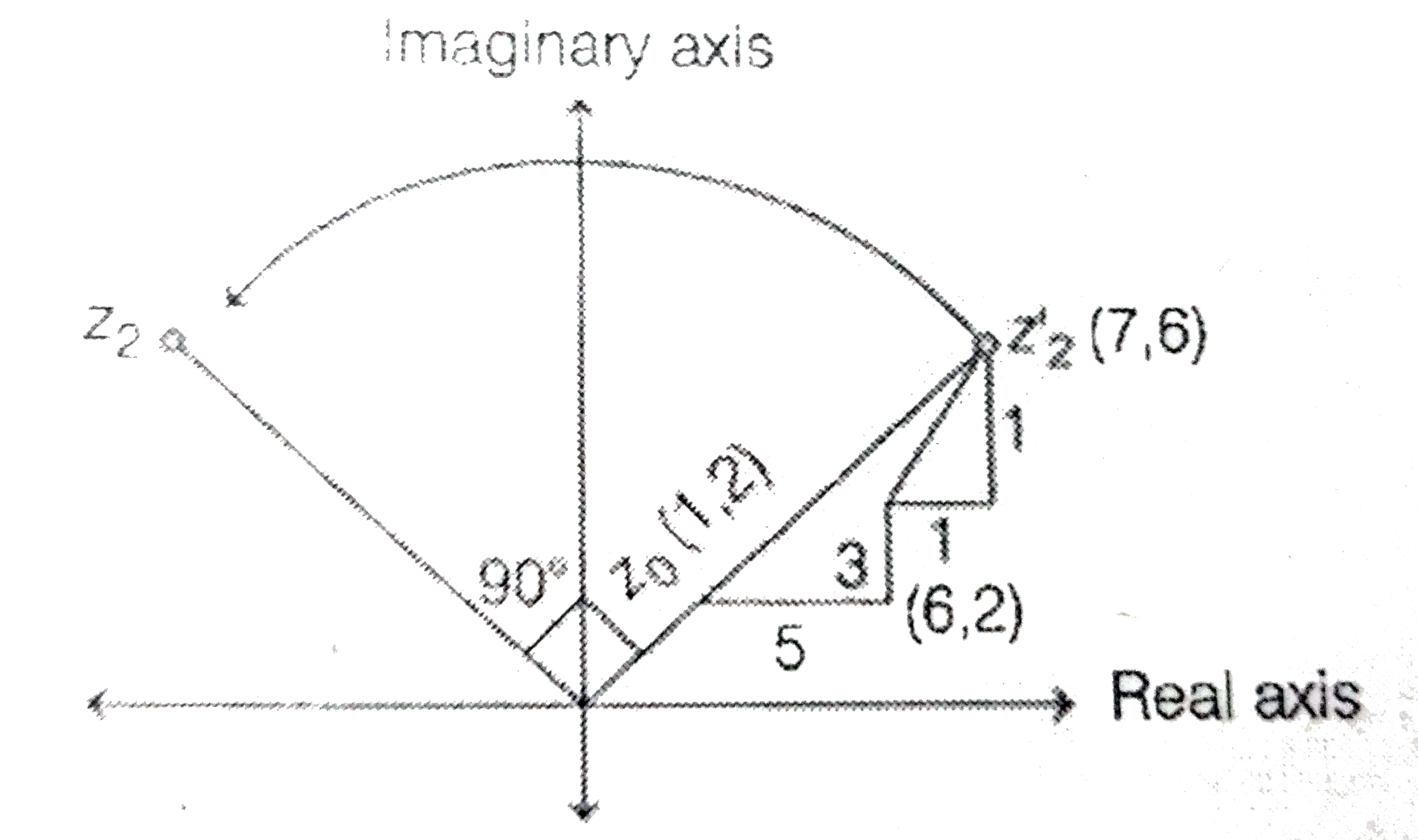A particle starts from a point z0=1+i where i=√−1. lt moves horizontally away from origin by 2 units and then vertically away from origin by 3 units to reach a point z1, From z1 particle moves √5 units in the direction of 2ˆi+3ˆj and then it moves through à n angle of cosec−12 in anticlockwise direction of a circle with centre at origin to reach a point z2. The arg z1 is given by
6+7i
−7+6i
7+6i
−6+7i
The correct Answer is:D

z2=(6+√2cos45∘,5+√2sin45∘) = (7,6)= 7 + 6i By rotaion about (0,0)
z2z2=eIπ/2⇒z2=z2(eiπ2)
=(7+6i)(cosπ2+isinπ2)=(7+6i)(i)=−6+7i
Topper's Solved these Questions
- BOOK - IIT JEE PREVIOUS YEARCHAPTER - COMPLEX NUMBERSEXERCISE - TOPIC 4 ROTATION OF A COMPLEX NUMBER (OBJECTIVE QUESTION II)(ONE OR MORE THAN ONE CORRECT OPTION)2videos
COMPLEX NUMBERS
- BOOK - IIT JEE PREVIOUS YEARCHAPTER - COMPLEX NUMBERSEXERCISE - TOPIC 4 ROTATION OF A COMPLEX NUMBER (FILL IN THE BLANKS )3videos
COMPLEX NUMBERS
- BOOK - IIT JEE PREVIOUS YEARCHAPTER - COMPLEX NUMBERSEXERCISE - TOPIC 3 ARGUMENT OF A COMPLEX NUMBER (OBJECTIVE QUESTIONS II)(ANALYTICAL & DESCRIPTIVE QUESTIONS )1videos
COMPLEX NUMBERS
- BOOK - IIT JEE PREVIOUS YEARCHAPTER - CIRCLEEXERCISE - Topic 5 Integer Answer type Question1videos
CIRCLE
- BOOK - IIT JEE PREVIOUS YEARCHAPTER - DEFINITE INTEGRATIONEXERCISE - LIMITS AS THE SUM6videos
DEFINITE INTEGRATION
Similar Questions
A particle P starts from the point z0=1+2i, where i=√−1 . It moves first horizontally away from origin by 5 units and then vertically away from origin by 3 units to reach a point z1. From z1 the particle moves √2 units in the direction of the vector ˆi+ˆj and then it moves through an angle π2 in anticlockwise direction on a circle with centre at origin, to reach a point z2. The point z2 is given by (a)6+7i (b) −7+6i (c)7+6i (d) −6+7i
View SolutionIf a complex number z=1+√3i is rotated through an angle of 120∘ in anticlockwise direction about origin and reach at z1, then z1 is
View Solution
Knowledge Check
- Question 1 - Select One
A particle P starts from the point z0=1+2i, where i=√−1 . It moves first horizontally away from origin by 5 units and then vertically away from origin by 3 units to reach a point z1. From z1 the particle moves √2 units in the direction of the vector ˆi+ˆj and then it moves through an angle π2 in anticlockwise direction on a circle with centre at origin, to reach a point z2. The point z2 is given by 6+7i (b) −7+6i 7+6i (d) −6+7i
A6 + 7iB−7+6iC7 +6iD−6+7i - Question 2 - Select One
A particle P starts from the point z0=1+2i, where i=√−1. It moves first horizontally away from origin by 5 units and then vertically away from origin by 3 units in the direction of the vector ˆi+ˆj and then it moves through an angle π2 in anticlockwise direction on a circle with center at origin, to reach a point z2. The point z2 is given by
A6+7iB−7+6iC7+6iD−6+7i - Question 3 - Select One
z1,z2,z3 are the vertices of an equilateral triangle taken in counter clockwise direction. If its circumference is at the origin and z1=1+i, then
Az2=z1ei2π/3,z3=eπ/3Bz2=z1ei2π/3,z3=z1ei4π/3Cz2=z1ei4π/3,z3=z1ei2π/3Dz2=z1eiπ/3,z3=z1ei2π/3
z1andz2, lie on a circle with centre at origin. The point of intersection of the tangents atz1andz2 is given by
View SolutionAll roots of the equation, (1+z)6+z6=0(A) lie on a unit circle with centre at the origin
View SolutionThe complex number z=1+i is rotated through an angle 3π2 in anti-clockwise direction about the origin and stretched by additional √2 unit, then the new complex number is:
View Solutionif the point z1=1+i where i=√−1 is the reflection of a point z2=x+iy in the line i¯z−iz=5 then the point z2 is
View SolutionThe complex number z = 1 + i is rotated through an angle 3π/2 anticlockwise direction about the origin and stretched by additional √2 units, then the new complex number is
View Solution

